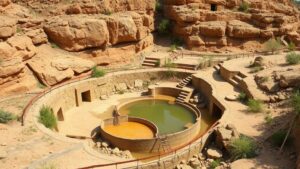Identifying Sediment Layers in Dry Washes That Indicate Gold Concentrations
Identifying Sediment Layers in Dry Washes That Indicate Gold Concentrations
The search for gold, often termed the gold rush, has driven countless explorers and miners into the wilderness of arid regions where dry washes serve as prevalent geological features. Dry washes, or ephemeral streams, are dry riverbeds that typically fill with water during infrequent rainfall. Identifying sediment layers within these washes can significantly enhance the likelihood of discovering gold concentrations. This article discusses the methods for identifying these layers and the geological principles involved.
Understanding Geology and Gold Deposits
Gold deposits are often found in areas with significant geological activity. As water flows through various terrains, it erodes minerals, including gold, which gets carried away and deposited elsewhere. In dry washes, understanding the geological context is essential for finding prospective locations. Factors such as locale age, the source of gold, and the flow patterns of ancient rivers all play crucial roles.
Key Sediment Layers to Identify
In dry washes, sediments typically accumulate in layers due to variations in flow rate, sediment size, and composition. Miners and geologists look for specific sediment layers that may indicate the concentration of gold:
- Floodplain Deposits: These are typically fine-grained layers formed during periods of flooding. Gold can accumulate in these deposits as heavier particles settle faster.
- Lag Deposits: Found at the base of a wash, these are where heavier materials, including gold, become concentrated as lighter sediments are washed away.
- Channel Deposits: Gold may be found in layers within the channel itself where water once flowed, particularly in ripples that form during high energy flow.
Methods for Identifying Gold-Influencing Sediments
Proper fieldwork is essential for identifying valuable sediment layers. Here are some commonly used methods:
- Visual Inspection: Look for distinct color changes in the sediment layers, which may signify different deposition events and mineral compositions.
- Suction Dredging: This method helps extract samples from underwater layers, revealing sediment composition and potential gold concentrations.
- Panning Samples: Taking samples of sediment and panning them can reveal the presence of gold particles.
Analyzing Sample Data
When field samples have been collected, they should be analyzed for gold content. Quantifying gold concentrations can be achieved through laboratory methods such as fire assay or atomic absorption spectroscopy. For example, a study conducted in Californias Sierra Nevada found that a particular dry wash contained gold concentrations averaging 0.5 grams per cubic meter, significantly influencing mining decisions.
Case Study: The Mojave Desert
The Mojave Desert showcases an exemplary scenario of gold detection in dry washes. Exploration in this region revealed that of over 100 identified dry washes, approximately 15% contained economically viable gold deposits. The sediments along these washes exhibited pronounced layering that geologists linked to ancient river flows and varying periods of erosion and deposition.
Addressing Common Concerns
Those interested in prospecting should bear in mind several considerations:
- Environmental Regulations: Always ensure compliance with local laws regarding mining and sediment extraction.
- Safety Precautions: Always be aware of environmental hazards, including unstable soils and wildlife.
- Investment of Time: Finding gold is often time-consuming and requires patience.
Conclusion and Actionable Takeaways
Identifying sediment layers in dry washes is a nuanced process steeped in geological understanding. Through diligent fieldwork, visual analysis, and proper extraction techniques, prospectors can increase their chances of locating gold concentrations. To enhance your gold prospecting efforts, invest time in studying the local geology, learn effective sampling methods, and meticulously document findings. By doing so, you position yourself favorably in the complex endeavor of gold mining in arid regions.

